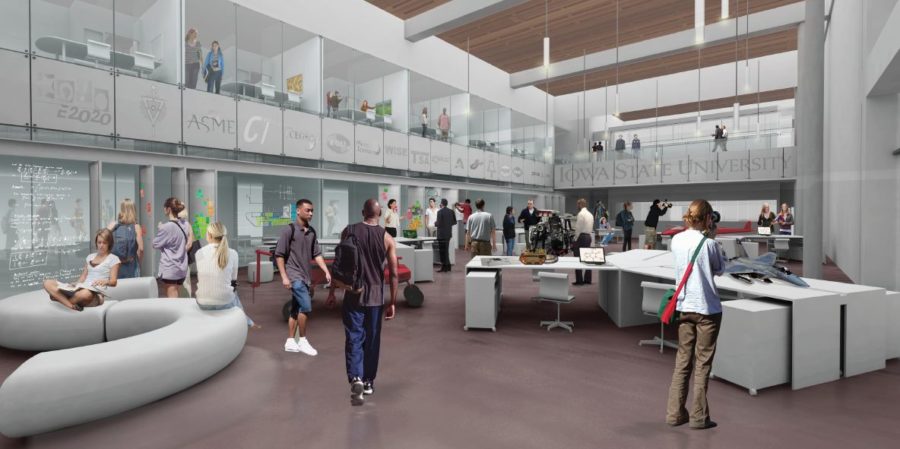New student innovation center to provide hands-on experience
Pictured is the design for the inside of the proposed Student Innovation Center, which will replace the Nuclear Engineering Laboratory and part of old Sweeney Hall.
September 16, 2014
Students in the colleges of engineering and design will soon have the opportunity to work with more hands-on projects in a new Student Innovation Center.
The center is a joint project between the two colleges and aims to provide students with a more modern space to work on class and organization projects, such as the Data Mining and PrISUm Solar Car teams, said Provost Jonathan Wickert.
Wickert also said students in other disciplines and studies will be able to use the center as well.
The space, approved by the Board of Regents at the September meeting, would be the central workspace hub to house resources students would use to complete projects.
“When you think about the Iowa State experience, it’s very hands on, very practical,” Wickert said. “There’s a lot of building, fabricating and innovating that goes on in the curriculum.”
The building is centered around the idea of “learning through making,” said Luis Rico-Gutierrez, dean of the College of Design.
“We learn through making,” Rico-Gutierrez said. “That is the big umbrella concept for that building. Our students and faculty can engage in learning through making.”
Many of the design and manufacturing labs are scattered around multiple buildings, Wickert said. The center would provide one location, open 24 hours a day, for students to work on projects.
Students would also have a chance to work with students in other disciplines, said Sarah Rajala, dean of the College of Engineering. She said this is important when students are posed with complex, real-world problems and situations.
“It’s not just an engineering student doing something,” Rajala said. “It’s students from multidisciplinary aspects and having a home where the students can come to and spend time together to learn how to solve these problems.”
The high-technology resources needed for many of the projects would be housed in this new center, Rajala said. Faculty and staff will play a role in the center, supervising and helping students with projects and making sure students know how to use the available technology.
“We need to be very responsible in the way we use the resources of the university and therefore the state,” Rico-Gutierrez said. “It is very smart to consolidate some of our more expensive equipment so that it is accessible to everybody.”
Hands-on projects and multi-discipline learning experiences help attract employers to Iowa State, Wickert said.
“Recruiters tell us they come here because our students have those kinds of skills,” he said.
Rajala also said the center will be an important aspect to helping students find jobs.
“It’s also going to be important from the standpoint of partnering with industry and making sure industry understands the kind of experience our students are getting,” she said. “It will be important to make sure we have all those companies try to hire our students.”
The proposed 175,000-square-foot center would be near the Marston Water Tower where the Nuclear Engineering Laboratory and the parking lot east of the lab currently stand.
The innovation center was approved as part of the 2016 fiscal year budget request to the state. The $80 million center’s funding will be split evenly between private fundraising and state funds.
The project is in the planning stage and will move forward if the budget is approved by the legislature at the end of the spring 2014 semester.
If approved, Rajala said she and other administrators would work on an in-depth design and infrastructure for the building.
Constructing an entirely new building is a more cost-effective move for the university than revamping the Nuclear Engineering Lab and Sweeney Hall, Rajala said. The buildings aren’t worth investing in because of their conditions, she said.
“Students are interested in participating in organizations, but we’re limited to what we can do because of the space that we have,” she said.
A new building would be a useful prospective student recruiting tool, Rajala said.
“The design is to make it very visible so that it is very easy to convey to people what it is being accomplished in that environment,” she said.
Both Rajala and Rico-Gutierrez said they look forward to the opportunities their students will have with the center.
“What it allows us to do is really better connect the experiences in the classroom with the co-curricular, out-of-classroom experiences,” Rajala said. “We can really look at the education of the students as a whole time they’re here.”

















